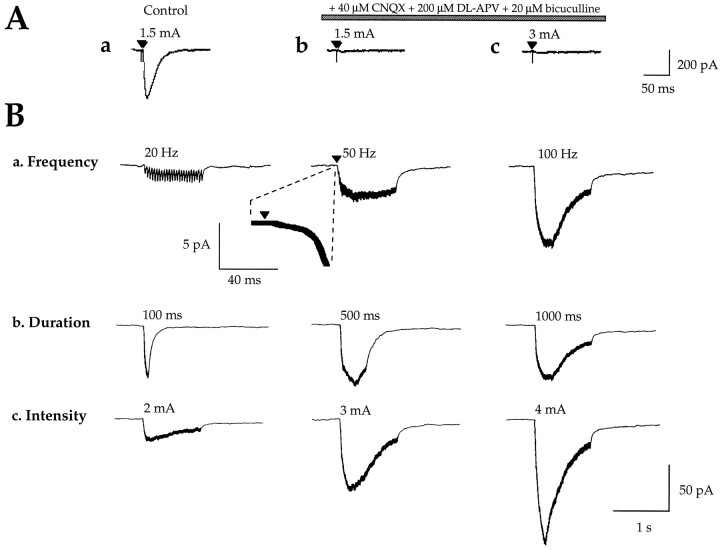Fig. 8.
High-frequency stimulation (HFS) evoked a slow inward postsynaptic current resistant to ionotropic glutamate (and GABAA) receptor antagonists. A, Postsynaptic response evoked in a CA1 pyramidal neuron (VH = −60 mV) by a single shock stimulation of 1.5 and 3 mA (60 μsec) in control conditions (A-a, 1.5 mA) and in the presence of CNQX (40 μm),dl-APV (200 μm), and bicuculline (20 μm) containing superfusion medium B (see Materials and Methods) (A-b, 1.5 mA; A-c, 3 mA). Note that the response to a single shock stimulation is blocked by the ionotropic glutamate and GABAA antagonists.B, Slow inward postsynaptic currents evoked as a function of HFS parameters in the presence of superfusion medium B (as in A-b, A-c; see Materials and Methods).B-a, Slow inward postsynaptic currents evoked by HFS (1 sec, 3 mA) with frequencies of 20, 50, and 100 Hz.Inset, Illustration of the onset of the response to tetanic stimulation at an expanded time scale. B-b, Slow inward postsynaptic currents evoked by HFS (100 Hz, 3 mA) with duration of 100, 500, and 1000 msec. B-c, Slow inward postsynaptic currents evoked by HFS (1 sec, 100 Hz) with stimulus intensities of 2, 3, and 4 mA. Note that the response to a single shock stimulation, even at high intensity (3 mA, 60 μsec), is blocked by ionotropic glutamate and GABAA antagonists, whereas in the same conditions the same stimulus delivered at high frequency (50–100 Hz, 1 sec) evokes a slow inward postsynaptic current.

